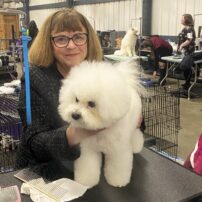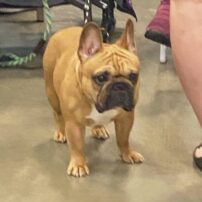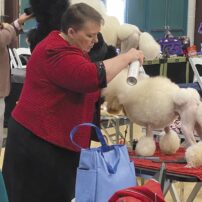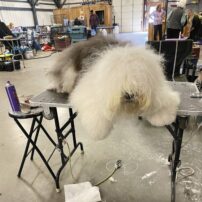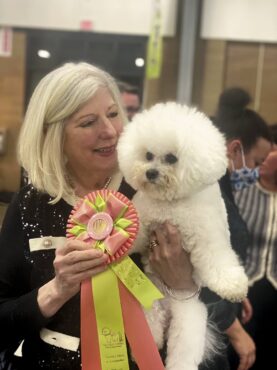 From Gig Harbor to Kingston, the residents of our area love their dogs. All you have to do is take a walk along one of the lovely sidewalks along the water or trails in the woods. Within seconds, you’ll discover that dogs — with their wagging tails, sniffing right to left and left to right — rule, not people. But showing dogs? As in, a dog show? Most think of the Philadelphia Kennel Club’s show on Thanksgiving afternoon, after the parade and before football games. It’s background noise to turkey basting and cranberry making.
From Gig Harbor to Kingston, the residents of our area love their dogs. All you have to do is take a walk along one of the lovely sidewalks along the water or trails in the woods. Within seconds, you’ll discover that dogs — with their wagging tails, sniffing right to left and left to right — rule, not people. But showing dogs? As in, a dog show? Most think of the Philadelphia Kennel Club’s show on Thanksgiving afternoon, after the parade and before football games. It’s background noise to turkey basting and cranberry making.
But there are resources in the area to learn about showing your dog and dog shows to attend. Most importantly, show dog owners would all agree, their dogs are pets first and show dogs second.
Gig Harbor resident Jan Rider is a typical amateur show dog owner and handler who says that her two bichons, Gracie and Elijah, are still the family’s companions.
“We play with them, and they are out in our environment with us,” Rider says.
Like many people who get into showing dogs, she and her husband, Mark, were originally looking for another pet after their second bichon died. The dog they purchased was considered of show quality, but the breeder was fine with them taking the pup to be a pet.
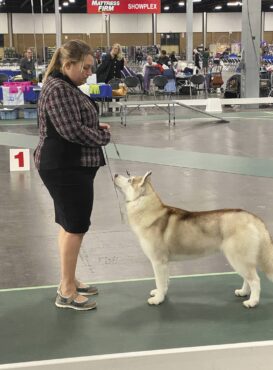 They began obedience training with someone who fell in love with Elijah and wanted to show him. While Elijah was getting better and better, earning points for his championship, the Riders got their girl, Gracie. Seeing how much fun Elijah was having in the ring, they began working with Gracie to enter the show world.
They began obedience training with someone who fell in love with Elijah and wanted to show him. While Elijah was getting better and better, earning points for his championship, the Riders got their girl, Gracie. Seeing how much fun Elijah was having in the ring, they began working with Gracie to enter the show world.
“I have really learned that you develop an eye for your breed and based upon that knowledge, you work with your dog to bring out the best qualities and to be competitive,” Rider explains.
Barbara and Tom Lewellen are longtime members of the Gig Harbor Kennel Club, which serves residents from Gig Harbor to Port Orchard, to Port Ludlow. They have owned and bred Great Danes since 1972. Being in a kennel club “helps you to learn about all the other breeds,” Tom Lewellen says. “You get a better idea of what the judge sees in dogs, and you get a supportive community.”
Barbara Lewellen adds that “a dog club is a great way to learn, a way to give to the community, but remember that the primary mission of a kennel club is to put on dog shows.”
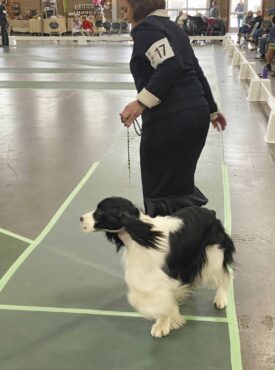 The Gig Harbor Kennel Club is recognized by the American Kennel Club (AKC) and not only does it put on dog shows, it has donated to the sheriff’s department so that it can purchase dogs and has worked with the Prison Pet Partnership program at the Washington Corrections Center for Women in Gig Harbor.
The Gig Harbor Kennel Club is recognized by the American Kennel Club (AKC) and not only does it put on dog shows, it has donated to the sheriff’s department so that it can purchase dogs and has worked with the Prison Pet Partnership program at the Washington Corrections Center for Women in Gig Harbor.
The Appeal of Dog Shows
But why a dog show in the first place? What does a dog do in a show?
The most familiar image of a dog show is a ring and a group of people either walking or running (depending upon the size of the dog) with their dog. This is called “conformation” and while it’s not the only way dogs can compete in AKC events, it’s the one that breeders and owners aspire to winning, especially if they want to breed their animal.
“The purpose of a dog show is to show quality, purebred dogs that represent the standard,” says Honey Glendinning, an internationally recognized show judge who resides in Canada. “The parent club for each breed develops the standards for that breed based upon what the dog is going to do. Remember, every dog, every breed has a job and that job is in the breed standard.”
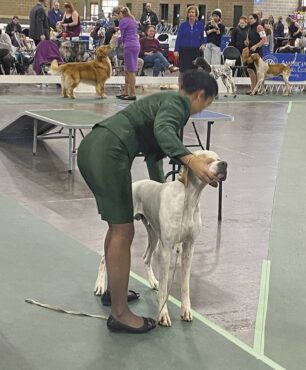 That’s why there are dog groups such as sporting (e.g., Labrador, cocker spaniel), hound (e.g., greyhound, basset hound, dachshund), working (e.g., boxer, rottweiler, mastiff), terriers (e.g., West Highland terrier, miniature schnauzer, Welsh terrier), toys (e.g., Chihuahua, pug, shih tzu), nonsporting (e.g., bichon frise, dalmatian, poodle) and herding (e.g., border collie, German shepherd, Pembroke Welsh corgi).
That’s why there are dog groups such as sporting (e.g., Labrador, cocker spaniel), hound (e.g., greyhound, basset hound, dachshund), working (e.g., boxer, rottweiler, mastiff), terriers (e.g., West Highland terrier, miniature schnauzer, Welsh terrier), toys (e.g., Chihuahua, pug, shih tzu), nonsporting (e.g., bichon frise, dalmatian, poodle) and herding (e.g., border collie, German shepherd, Pembroke Welsh corgi).
Each dog’s line has a purpose. For example, a Labrador retriever’s main job is to flush out birds and to bring them back to the hunter undamaged to be used for dinner. The popular French bulldog (who is actually English) has a lineage going back several hundred years and was bred to be a smaller animal than the standard English bulldog.
According to the breed club, French bulldogs were quite popular with artisans and lace makers in the English midlands. With the advent of the Industrial Revolution, they were transported to France and made their way to Paris where, with their cute upright ears, they became the favorite of “les belles de nuit”or Parisian streetwalkers. Thus the little dog fits into the nonsporting group as a domesticated house pet.
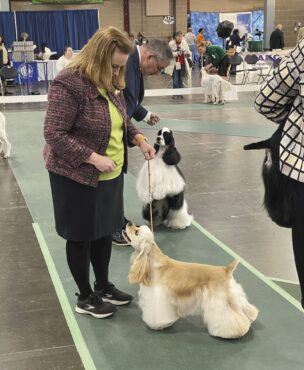 Choosing a Purebred Dog
Choosing a Purebred Dog
Gig Harbor is also home to another internationally recognized judge, Christie Martinez. AKC judges work hard and are constantly traveling. Martinez, who has been judging for 22 years, is on the road an average of 20 weekends a year. When asked why people should get a purebred dog rather than a mixed breed, Martinez says that “a good breeder is going to make sure that both the bitch (female dog) and the dog (male dog) are healthy and together will bring out the best for that breed’s standards.”
Martinez emphasizes that each breed has different issues and new owners should make sure that the puppy’s parents have had certified tests of their eyes, heart and hips. New dog owners should not shortcut the process, making sure the breeder will let you meet the parents (at least the bitch). Good breeders also want to know something about the home the puppy is going to.
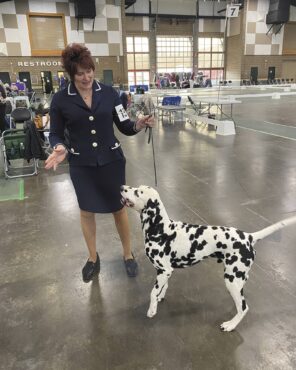 Don’t be surprised if the breeder asks a lot of questions, such as how long the puppy will be alone during the day, if the puppy will be kept inside, and if there’s a fenced, safe yard for it. Sometimes, people will pose as a reputable breeder but as in anything, check the breeder out. Don’t just give cash to a breeder and get a puppy at a gas station.
Don’t be surprised if the breeder asks a lot of questions, such as how long the puppy will be alone during the day, if the puppy will be kept inside, and if there’s a fenced, safe yard for it. Sometimes, people will pose as a reputable breeder but as in anything, check the breeder out. Don’t just give cash to a breeder and get a puppy at a gas station.
Most importantly, know that when selecting a dog, a mixed-breed pup can have the best of breeds intermingled with the worst. Look to the breed standards for each breed the puppy is mixed with to get an idea of what needs it may require. A purebred dog will be bred to strict breed standards, and the chances of getting a pup that will fit best into the family’s lifestyle are greatly improved.
When asked the question about adopting from a shelter versus seeking a purebred dog, both Martinez and Glendinning agree that when a shelter dog is adopted, the new owner is doing a service to the animal. But new owners really won’t know the dog’s mix and personality, nor any potential health complications in the future.
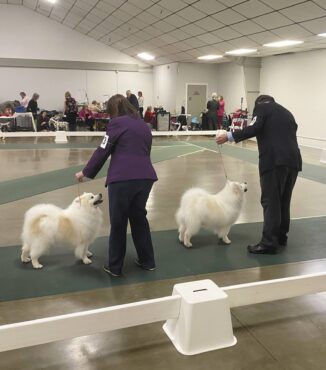 “If you are getting a purebred dog that meets the standards, you will have a companion for life that will never faulter,” Martinez says.
“If you are getting a purebred dog that meets the standards, you will have a companion for life that will never faulter,” Martinez says.
All of the dog owners reiterated the importance of training. “You are training the dog, but you are also training you,” Rider says. “You are developing that relationship with your dog and showing that you are the alpha of the pack. You have to be consistent.”
Shedding a bit of reality to the importance of training, Tom Lewellen says, “A dog sees the world differently than we do. You have to respect that, and the dog has to trust and respect you.”
Dog owners and potential dog owners are always invited and encouraged to attend dog shows; they are free, but remember, pet dogs may not attend, as show dogs in competition are excited and alert. The next big dog show in our area is the Western Washington Cluster, sponsored by the Gig Harbor Kennel Club, the Puyallup Valley Dog Fanciers and the Seattle Kennel Club, on July 5 (breed specialties only) and July 6 – 8 (all breed) at the Western Washington Fairgrounds in Puyallup.




